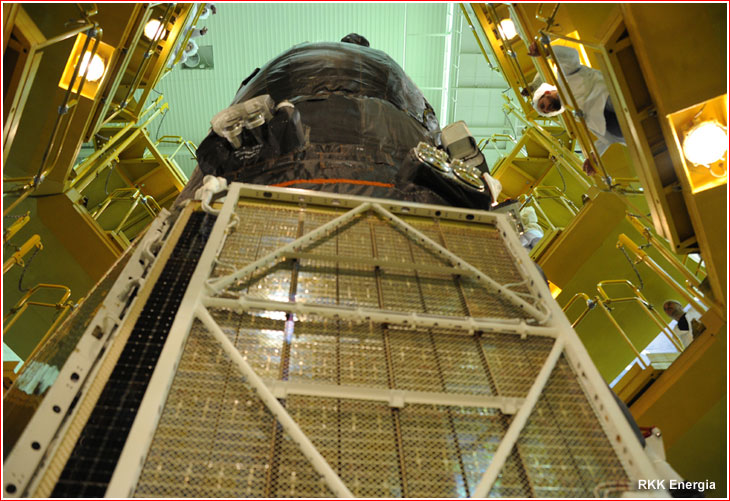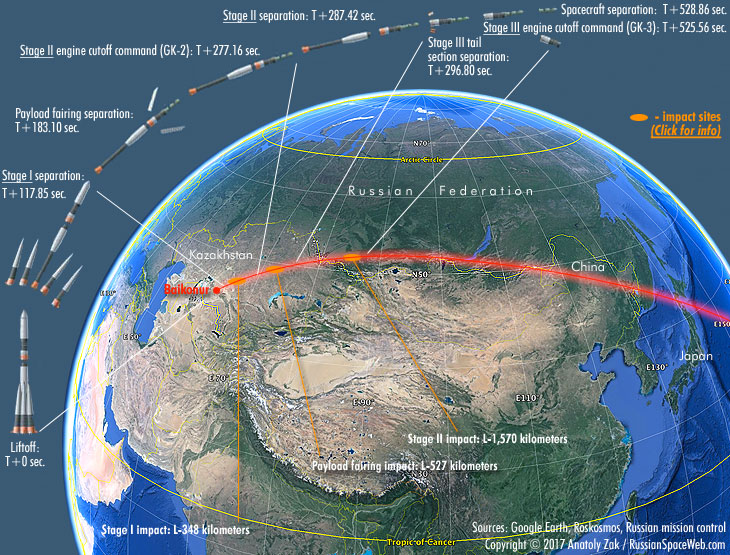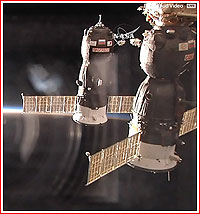Progress MS-07 arrives at ISS (original) (raw)
Mission of Progress MS-07 to ISS
After a two-day delay due to technical problems, the Progress MS-07 cargo mission to resupply the ISS lifted off on Oct. 14, 2017, at 11:46:53 Moscow Time (4:46 a.m. EDT). The spacecraft successfully entered orbit and docked at the station two days later on October 16, 2017, at 6:04 a.m. Houston Time.
See more in:
Previous mission: Progress MS-06

Progress MS-07 lifts off on Oct. 14, 2017.
From the publisher: Pace of our development depends primarily on the level of support from our readers!
Progress MS-07 mission at a glance:
| Spacecraft designation(s) | Progress MS-07, 11F615 No. 437 |
|---|---|
| Launch vehicle | Soyuz-2-1a |
| Launch site | Baikonur, Site 31, Pad 6 |
| Mission | Unmanned cargo delivery to the ISS |
| Spacecraft mass | 7,428 kilograms |
| Launch date and time | 2017 Oct. 14, 11:46:53.478 Moscow Time |
| Docking date | 2017 Oct. 16, 14:09:57 Moscow Time (planned); 14:04:07 Moscow Time (actual) |
| Destination | Russian segment, Pirs Docking Compartment (SO1), nadir port |
| End of mission | 2018 March (planned) |
Preparing the Soyuz-MS transition
When it appeared in the ISS flight manifest in 2014, the Progress MS-07 mission was penciled for April 16, 2017. As part of a routine schedule realignment, the flight eventually ended up in the second half of the year.
Continuing a long tradition of cargo ships serving as test vehicles for hardware and techniques intended for future cosmonaut flights, the Progress MS-07 mission was used to prepare the transition of the Soyuz-MS spacecraft from the Soyuz-FG to the Soyuz-2-1a rockets. To that extent, the Soyuz-2-1a rocket with the Progress MS-07 spacecraft was rotated in its launch structure at Site 31 to match an ascent azimuth of around 60 degrees. Ironically, the new-generation flight control system aboard Soyuz-2-1a does not require the rocket face a certain direction on the launch pad, because it can turn the vehicle to the right azimuth during the ascent. However, the Emergency Escape System, SAS, attached to the top of each spacecraft with cosmonauts onboard and designed to pull the crew capsule away from the failing rocket, is not that flexible. Its own internal guidance mechanism requires the rocket point at a certain direction with a two-degree accuracy as soon as the SAS system is activated on the launch pad before liftoff. Therefore, during the launch of the Progress MS-07 spacecraft, engineers decided to simulate the exact flight profile that would be later employed during launches of the Soyuz MS spacecraft on the Soyuz-2-1a rocket.
The same goal of simulating the Soyuz-MS ascent also required to shift the release of the payload fairing protecting the spacecraft during the ascent through the dense atmosphere to a period of firing of the rocket's second stage rather than the third stage, as it had been done in the previous Progress launches on the Soyuz-2-1a rocket. Finally, the liftoff mass of the Progress MS-07 spacecraft was to be brought up to 7,440 kilograms, or almost 150 kilograms heavier than that of the previous cargo ship. (The actual mass of the spacecraft was reported to be 7,428 kilograms.)
The Roskosmos State Corporation approved the new test flight profile for the Progress MS-07 mission on June 2, 2017.
Shorter rendezvous profile
If it could lift off as originally scheduled on Oct. 12, 2017, Progress MS-07 was expected to rehearse a new rendezvous profile with the ISS which would allow the ship's docking at the station just 3.5 hours after a liftoff from Baikonur. The two-orbit rendezvous method would cut in half the shortest time that has been required to reach the ISS so far. However, it should be noted that the two-orbit rendezvous scenario is not record-breaking in the history of space flight either in Russia or elsewhere. For example, the world's first automated docking between the pair of unmanned Soyuz 7K-OK spacecraft nearly 50 years ago was accomplished in just 77 minutes after the liftoff of the chase vehicle. Still, the shortening of the ferry flight to the ISS will be welcomed news for Soyuz fliers, because during the current six-hour rendezvous process, their typical work day lasts up to 16 hours including 10 hours in a spacesuit, which is close to the limit of discomfort even for seasoned pilots. (817)
Progress MS-07 was orginally scheduled to dock with ISS at 8:56 a.m. EDT (15:56 Moscow Time) on October 12, 2017, at the Pirs Docking Compartment, SO1, on the Russian segment, where it was expected to remain until March 2018.
Progress MS-07 launch campaign
On Sept. 29, 2017, RKK Energia, the ship's prime developer, announced that its team in Baikonur Cosmodrome had completed loading of the propellant components and pressurized gases onboard Progress MS-07 and the vehicle had been brought back to the spacecraft processing building, MIK KA, at Site 254, where it had been installed in a vertical position inside its access rig for the final pre-launch processing. On October 4, Progress MS-07 was attached to the launch vehicle adapter ring which was to serve as an interface with its Soyuz-2-1a rocket. On October 5, specialists at RKK Energia conducted the final visual inspection of the cargo ship, after which, the vehicle was lowered into a horizontal position and rolled inside its protective payload fairing. The next day, the payload section, including the spacecraft, its fairing and its launch vehicle adapter, was loaded on a railway trailer and transported to the vehicle assembly building at Site 31 for integration with its rocket. The rollout to the launch pad took place on the morning of October 10.

Progress MS-07 during the final visual inspection on Oct. 5, 2017.
Secret payload onboard?
Typically for the Progress cargo missions, the latest spacecraft was expected to provide resupply for the ISS crew, delivering fuel, water, food and other consumables. Among the cargo reported to be carried on the Progress MS-07 mission was the long-delayed hardware for the Russian Luch-5 data-relay satellite system, which allows the over-the-horizon communications with ground control, and a small robotic device to promote a Russian social media web site.
Interestingly, available photos of the Progress MS-07 spacecraft during the pre-launch processing revealed an unusual instrument attached to the front of the vehicle at a location where normally would be no sensors or other payloads, with the exception of the Otrazhenie ("reflection") experiment which had a different external appearance. As of October 6, Roskosmos has provided no explanation for that particular piece of hardware even on request from NASA. Russian space officials said only that this is a "one-time scientific experiment."

Read more about the unidentified payload here...
Initial launch attempt
Aiming to set a record in express cargo delivery to the International Space Station, ISS, the Progress MS-07 mission was first set to lift off on October 12, 2017, at 12:32:06 Moscow Time (5:32 a.m. EDT). However, despite good weather at Baikonur Cosmodrome, the liftoff was scrubbed around 12 seconds before the ignition. At that time, the main (tall) umbilical mast connected to the third stage of the rocket had already retracted, but the second mast serving the core stage had remained attached to the vehicle. According to NASA, an electrical problem prevented the separation of the mast, interrupting the automated launch sequence.
According to sources at Roskosmos, the problem that had caused the scrub required the replacement of a flight control computer onboard the launch vehicle before the second launch attempt could be made. However there was no public explanation about the culprit in the incident.
Shortly after the scrub, Roskosmos announced that the next launch opportunity for Progress MS-07 would be on October 14, 2017, at 11:46:53 Moscow Time (4:46 a.m. EDT), however the mission would have to follow a two-day, 34-orbit rendezvous profile with the station, rather than a 3.5-hour, two-orbit flight scenario originally planned for this flight. As a result, the docking with the ISS had to be rescheduled for Oct. 16, 2017.
Progress MS-07 lifts off on the second try

After a two-day delay, the Soyuz-2-1a rocket carrying the Progress MS-07 spacecraft lifted off on Oct. 14, 2017, at 11:46:53 Moscow Time (4:46 a.m. EDT), as the International Space Station, ISS, was flying over the South Atlantic.
Following a vertical liftoff, the launch vehicle headed eastward from Baikonur matching an orbital inclination of 51.66 degrees toward the Equator. The four boosters of the first stage separated nearly two minutes into the flight, while the second stage continued firing until 4.7 minutes into the flight.
Before the separation of the second stage, the payload fairing protecting the spacecraft split into two halves and fell off.
The third stage ignited moments before the separation of the second stage, firing its engine through a lattice structure connecting the two boosters and ensuring the continuous thrust during the entire ascent to orbit. A fraction of a second later, the aft cylindrical section of the third stage split into three segments and dropped off, ensuring the fall of all the debris into the same drop zone 1,576 kilometers from the launch site.
In the meantime, the third stage kept firing until almost nine minutes into the flight. According to Roskosmos, Progress MS-07 separated from the third stage of the launch vehicle eight minutes and 48 seconds after liftoff. The Russian mission control in Korolev said that the separation of the spacecraft from the third stage had taken place at 11:55:42 Moscow Time (planned separation time was 11:55:41.86 Moscow Time).
According to the mission control, Progress MS-07 entered a close-to-planned initial orbit with following parameters:
| Parameter | Planned orbit | Actual orbit |
|---|---|---|
| Orbital period | 88.54 minutes (+/-0.067 minutes) | 88.55 minutes |
| Inclination | 51.67 degrees (+/-0.033 degrees) | 51.671 degrees |
| Perigee (lowest altitude) | 193 kilometers (+/-2 kilometers) | 192.9 kilometers |
| Apogee (highest altitude) | 240 kilometers (+/-7 kilometers) | 241.2 kilometers |
At the time when the Progress-MS-07 reached its initial orbit, the ISS was projected to be in a 401.13 by 423.69-kilometer orbit, 237.1 degrees away from the cargo ship in the so-called phasing angle. Without any additional maneuvers, the spacecraft would remain in orbit for around 30 hours or 20 revolutions around the Earth.
Progress MS-07 heads to the station
Following its successful launch on October 14, 2017, Progress MS-07 embarked on a two-day chase of the International Space Station. The flight profile called for two orbit corrections with the ship's main engine on the day of the launch, followed by a single maneuver on October 15.
The three maneuvers were scheduled to be initiated according to the following timeline and had to result in following orbital parameters:
| Orbit No. | Moscow Time | Firing duration | delta V | Period | Inclination | Resulting perigee | Resulting apogee |
|---|---|---|---|---|---|---|---|
| Day 1 of the mission (2017 Oct. 14) | |||||||
| 3 | 15:17:53 | 86.1 seconds | 34.30 m/s | 89.71 minutes | 51.67 degrees | 207.4 kilometers | 322.3 kilometers |
| 3 | 15:58:14 | 81.1 seconds | 32.69 m/s | 90.85 minutes | 51.66 degrees | 319.7 kilometers | 335.6 kilometers |
| Day 2 of the mission (2017 Oct. 15) | |||||||
| 18 | 13:23:21 | 29.6 seconds | 2.00 m/s | 90.92 minutes | 51.66 degrees | 320.2 kilometers | 341.3 kilometers |
According NASA, all the orbit correction maneuvers had been completed successfully.
The autonomous rendezvous process between the spacecraft and the station was to be initiated on October 16, at 11:48:56 Moscow Time (4:48 a.m. EDT). Final maneuvers, including flyaround of the station, station-keeping and berthing were scheduled to commence at 13:47:58 Moscow Time (6:47 a.m. EDT) on the same day.
Progress MS-07 was scheduled to dock at Earth-facing port of the Pirs Docking Compartment, SO1, a part of the Russian segment of the ISS on Oct. 16, 2017, at 14:09:57 Moscow Time (7:09 a.m. EDT), Roskosmos said. However due to smooth operation of all systems, the actual docking took place around five minutes earlier, at 6:04 a.m. Houston Time, NASA said. The Russian mission control confirmed the docking at 14:04:07 Moscow Time.
Russian cosmonauts Sergey Ryazansky and Aleksandr Misurkin aboard the ISS were monitoring the approach and docking of the Progress MS-07 cargo ship, the Russian mission control said.
At the time of the launch, the spacecraft was expected to remain docked at ISS for five months until March 2018.
Cargo aboard Progress MS-07:
| Propellant in the refueling tanks | 700 kilograms |
|---|---|
| Compressed air in the Oxygen Supply System, SrPK | 22 kilograms |
| Oxygen in the Oxygen Supply System, SrPK | 25 kilograms |
| Water in the Rodnik system | 420 kilograms |
| Total mass of supplies in the pressurized cargo compartment, including... | 1,382 kilograms |
| Gas Content System | 36 kilograms |
| Water Supply System | 356 kilograms |
| Thermal Control System | 25 kilograms |
| Power Supply System | 89 kilograms |
| Servicing and Repair System | 10 kilograms |
| Onboard systems control | 4 kilograms |
| Wide-band communications | 33 kilograms |
| Regul-OS control and communications system | 15 kilograms |
| Personal protection gear | 72 kilograms |
| Medical supplies | 131 kilograms |
| Containers with food rations, fresh food items | 303 kilograms |
| Hyegene and sanitary supplies | 66 kilograms |
| Onboard documentation, packages for the crew, video and photo equipment | 32 kilograms |
| Expendable materials and equipment for onboard experiments | 38 kilograms |
| A handle with connectors for Progress M docking system, SSVP | 3 kilograms |
| Hardware for MIM1 Rassvet module | 6 kilograms |
| NASA cargo for Russian and US crew members | 165 kilograms |
| Total mass of cargo | 2,549 kilograms |
End of mission
Progress MS-07 undocked from the Pirs SO1 Docking Compartment on March 28, 2018, at 16:50:30 Moscow Time. The vehicle then remained in orbit for nearly a month to conduct Otrazhenie (reflection) and Izgib (bend) experiments, which dealt with atmospheric phenomena and microgravity conditions aboard the spacecraft respectively, the official Russian press said.
During the Otrazhenie experiment, TV cameras were to image the Earth's atmosphere with varying Sun angles to study its properties.
The Izgib experiment was designed to compare dynamic conditions aboard the spacecraft during spin stabilization and solar orientation, the Interfax news agency said.
The deorbiting operations began on April 26, 2018, with a 205-second engine firing starting at 07:08 Moscow Time. According to mission control, Progress MS-07 reentered the dense atmosphere at 07:42 Moscow Time and its surviving debris were estimated to hit the surface of the Pacific Ocean at 07:51 Moscow Time.
Read much more about history of the Russian space program in a richly illustrated, large-format glossy edition:
This page is maintained by Anatoly Zak; Last update:April 26, 2018
Page editor: Alain Chabot; Last edit: October 11, 2017
All rights reserved
Progress MS-07 is being transported to vehicle assembly building on Oct. 6, 2017, for integration with its Soyuz-2-1a rocket scheduled for Oct. 9, 2017. Click to enlarge. Credit: RKK Energia

Progress MS-07 successfully docked at ISS on Oct. 16, 2017, at 14:04:07 Moscow Time (7:04 a.m. EDT) around five minutes ahead of schedule. Credit: NASA



)
)
)
)
)
)
)
)
)